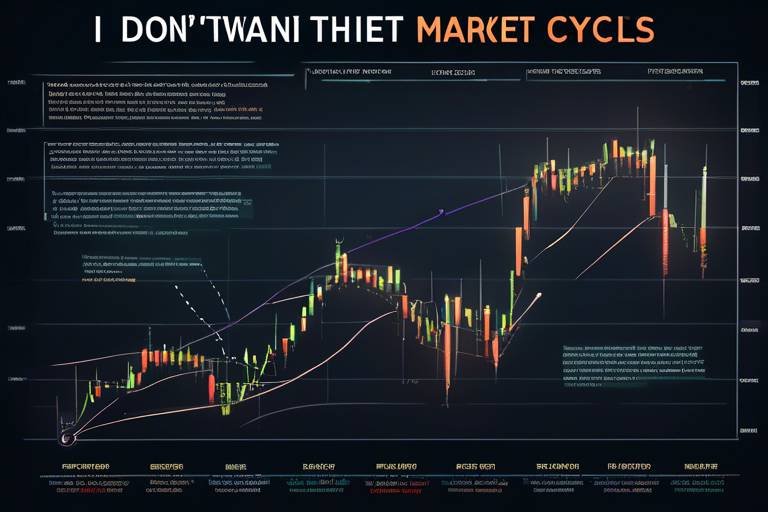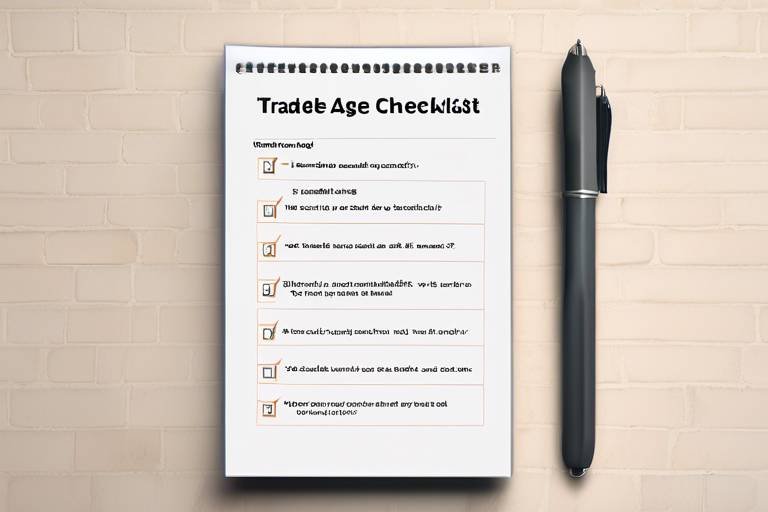The Role of Patience in Successful Trading
Trading in the financial markets can often feel like a rollercoaster ride, filled with unexpected twists and turns. In this thrilling environment, one vital quality stands out: patience. It's not just a virtue; it's a cornerstone of successful trading. Patience enables traders to bide their time, waiting for the perfect moment to strike while avoiding the pitfalls of impulsive decisions. Imagine a lion lurking in the grass, patiently observing its prey before making a calculated move. This analogy perfectly encapsulates the essence of patience in trading.
In the fast-paced world of trading, where emotions can run high and the pressure to act can be overwhelming, maintaining a patient approach can be the difference between success and failure. Patience fosters a disciplined mindset, allowing traders to adhere to their strategies without succumbing to the temptation of chasing after fleeting opportunities. Instead of reacting to every market fluctuation, a patient trader takes a step back, assessing the situation with a calm and collected perspective.
Moreover, the financial markets are notorious for their volatility. Prices can swing dramatically in a matter of moments, and this unpredictability can trigger emotional reactions. However, those who embrace patience are better equipped to navigate these ups and downs. They understand that the market is like an ocean, with waves that rise and fall. By maintaining a strategic view, patient traders can avoid getting swept away by the tide of emotions.
To illustrate the importance of patience, consider the following points:
- Waiting for Opportunities: Patience allows traders to wait for the right setups, ensuring they only enter trades that meet their criteria.
- Emotional Control: A patient mindset helps traders manage their emotions, reducing the likelihood of making rash decisions based on fear or greed.
- Long-Term Success: By focusing on gradual progress rather than quick wins, patient traders set themselves up for sustainable success.
In conclusion, patience is not merely a passive quality; it is an active strategy that empowers traders to make informed decisions and maintain a long-term perspective. As we delve deeper into the various aspects of trading, we'll explore how patience plays a critical role in understanding market fluctuations, risk management, and building a resilient trading mindset.

The Importance of Patience in Trading
This article explores how patience is a critical virtue in trading, impacting decision-making, risk management, and overall success in the financial markets.
In the fast-paced world of trading, where every second counts and market conditions can change in the blink of an eye, patience often takes a backseat. However, it is a crucial element that can significantly influence a trader's success. Imagine a hunter waiting silently for the perfect moment to strike; this is how traders should approach their strategies. By exercising patience, traders can wait for the right opportunities to present themselves, reducing the likelihood of making impulsive decisions that could lead to substantial losses.
Patience fosters a disciplined approach, which is essential for long-term success in fluctuating markets. Without it, traders may find themselves chasing after every market movement, leading to a chaotic trading experience filled with regret and missed opportunities. Instead of reacting hastily, a patient trader can take a step back, evaluate the situation, and make informed decisions based on careful analysis rather than emotions.
Moreover, patience allows traders to develop a deeper understanding of the market dynamics. By waiting and observing, they can identify key trends and patterns that may not be immediately apparent. This strategic perspective is invaluable, especially when navigating the unpredictable nature of financial markets. A trader who understands the importance of patience is like a seasoned sailor, skillfully steering through turbulent waters while others are tossed about by the waves.
Incorporating patience into trading practices can also lead to better risk management. When traders take the time to assess their options and wait for favorable conditions, they are more likely to make calculated decisions that align with their risk tolerance. For instance, a trader might choose to wait for a stock to reach a certain price point before entering the market, rather than jumping in at the first sign of movement. This approach not only maximizes potential profits but also minimizes losses, creating a more sustainable trading strategy.
Ultimately, the importance of patience in trading cannot be overstated. It is the backbone of a successful trading strategy, allowing traders to maintain focus, discipline, and a clear mind in the face of market volatility. By embracing patience, traders can transform their approach, leading to more consistent and rewarding trading experiences.
Market fluctuations can be unpredictable. Patience helps traders navigate these ups and downs, enabling them to maintain a strategic perspective rather than reacting emotionally.
Traders must identify patterns over time. Patience allows for thorough analysis, helping to distinguish between fleeting trends and significant market movements.
Using technical analysis requires a patient mindset. Traders must wait for confirmation signals before acting, ensuring more informed decisions.
Fundamental analysis also demands patience. Evaluating economic indicators and company performance takes time but is crucial for making sound investment choices.
Successful trading hinges on timing. Patience empowers traders to wait for optimal entry and exit points, maximizing potential profits and minimizing losses.
Effective risk management is rooted in patience. Traders who exercise patience can better assess risk-reward ratios, leading to more calculated and less emotional trading decisions.
Patience aids in setting achievable trading goals. Traders who understand the importance of gradual progress are less likely to chase quick profits, leading to sustainable success.
Every trader makes mistakes. Patience allows for reflection and learning, transforming setbacks into valuable lessons that can enhance future trading strategies.
Cultivating a patient mindset is essential for traders. This involves developing emotional control, practicing mindfulness, and focusing on long-term objectives rather than short-term gains.
- Why is patience considered a virtue in trading?
Patience allows traders to make informed decisions, wait for the right opportunities, and avoid impulsive actions that can lead to losses. - How can I develop patience as a trader?
Practicing mindfulness, setting realistic goals, and reflecting on your trading experiences can help cultivate a patient mindset. - What are the risks of being impatient in trading?
Impatience can lead to hasty decisions, increased risk exposure, and ultimately, greater losses in the market.

Understanding Market Fluctuations
Market fluctuations can sometimes feel like riding a roller coaster—full of ups, downs, and unexpected turns. Just when you think you’ve got it all figured out, the market throws you a curveball. That’s why understanding these fluctuations is crucial for any trader looking to navigate the financial landscape successfully. Instead of reacting impulsively to every market shift, a patient trader takes a step back to analyze the situation, maintaining a strategic perspective that can lead to more informed decisions.
One of the key components of understanding market fluctuations is recognizing that they are often driven by a variety of factors, including economic indicators, geopolitical events, and market sentiment. These elements can create a chaotic environment where prices swing wildly. For instance, news about interest rate changes can send stock prices soaring or plummeting within minutes. Here’s a quick breakdown of some common factors that contribute to market fluctuations:
- Economic Indicators: Reports on employment, GDP growth, and inflation can influence trader sentiment.
- Geopolitical Events: Political instability or international conflicts can create uncertainty in the markets.
- Market Sentiment: The collective mood of investors can drive prices up or down, sometimes regardless of the underlying fundamentals.
Patience plays a vital role in how traders respond to these fluctuations. Instead of jumping on every piece of news or reacting to market swings, a patient trader waits for the right moment to act. This waiting game is not about being passive; rather, it’s about being strategically active. By observing and analyzing market trends over time, traders can distinguish between temporary fluctuations and significant shifts that warrant action.
Another important aspect of understanding market fluctuations is recognizing patterns. Markets often repeat behaviors based on historical data. For example, certain stocks may tend to rise during specific seasons or economic conditions. By taking the time to study these patterns, traders can better anticipate future movements, allowing them to position themselves advantageously. This is where technical analysis comes into play, as it relies heavily on historical price data to identify potential trends.
In conclusion, market fluctuations are an inevitable part of the trading experience. However, by cultivating patience and a deep understanding of the factors that drive these changes, traders can navigate the turbulent waters of the financial markets with greater confidence. Remember, it’s not just about making quick trades; it’s about making smart trades that align with your overall strategy. So, the next time you find yourself facing a market upheaval, take a deep breath, step back, and let patience guide your decision-making process.
- What causes market fluctuations? Market fluctuations are caused by various factors, including economic indicators, geopolitical events, and changes in market sentiment.
- How can patience help in trading? Patience allows traders to wait for the right opportunities, analyze market trends, and make informed decisions without succumbing to emotional reactions.
- What is technical analysis? Technical analysis is the study of past market data, primarily price and volume, to forecast future price movements.
- Why is it important to recognize market patterns? Recognizing market patterns helps traders anticipate future movements, allowing them to make better-informed trading decisions.

Recognizing Patterns
In the ever-evolving world of trading, recognizing patterns is akin to being a detective piecing together clues to solve a mystery. Just as a detective relies on experience and intuition, traders must hone their ability to identify patterns in market behavior over time. This skill is not merely about spotting trends; it’s about understanding the underlying forces that drive those trends. Patience plays a pivotal role here, as it allows traders to step back and analyze data without the rush of impulsive decision-making.
When traders exhibit patience, they give themselves the opportunity to observe market movements and recognize recurring patterns. These patterns can often signal potential price movements, providing crucial insights that can inform trading strategies. For instance, a trader might notice that a particular stock tends to rise after a series of lower highs, indicating a possible reversal. By waiting for these signs to manifest rather than jumping at the first hint of movement, traders can position themselves for greater success.
To effectively recognize patterns, traders often utilize various technical analysis tools. Here are some common patterns that can emerge in trading:
- Head and Shoulders: This pattern indicates a reversal and is formed by three peaks—one higher peak (head) between two lower peaks (shoulders).
- Double Top and Bottom: These patterns signal potential reversals in market direction, with double tops indicating a bearish reversal and double bottoms suggesting a bullish reversal.
- Triangles: Ascending, descending, and symmetrical triangles indicate potential continuation or reversal of trends, depending on the breakout direction.
However, it’s important to remember that recognizing patterns is not an exact science. Market conditions can change rapidly, and what once seemed like a clear pattern can quickly dissipate. This is where patience becomes invaluable. Instead of rushing to make trades based on incomplete information, a patient trader will wait for confirmation signals that validate their observations. This might involve waiting for a specific price point to be reached or for additional indicators to align with their analysis.
Moreover, developing the skill of pattern recognition requires consistent practice and a willingness to learn from past experiences. Traders should keep a trading journal, documenting their observations, trades, and the outcomes. Over time, this practice can enhance their ability to recognize patterns and improve their overall trading strategies.
In conclusion, recognizing patterns is a fundamental skill for traders, and it is one that flourishes in an environment of patience. By taking the time to analyze market behaviors and waiting for the right signals, traders can make more informed decisions that lead to greater success in their trading endeavors.

Technical Analysis Techniques
When it comes to technical analysis, patience is not just a virtue; it's a necessity. Traders often rush into trades based on fleeting signals or gut feelings, but those who truly understand the market know that waiting for the right moment can make all the difference. Technical analysis involves studying historical price movements and identifying patterns, which requires a keen eye and a patient mindset. Instead of jumping at the first sign of a trend, successful traders wait for confirmation signals. This means they look for specific indicators that suggest a trend is likely to continue rather than reverse.
For example, consider the moving averages. Many traders use the crossover of short-term and long-term moving averages as a signal to buy or sell. However, if a trader acts impulsively at the first crossover without waiting for additional confirmation, they might find themselves on the wrong side of a trade. By exercising patience and waiting for a clear trend to establish itself, traders can significantly increase their chances of success.
Another essential technique is the use of support and resistance levels. These levels represent psychological barriers where traders are likely to buy or sell. A patient trader will wait to see if the price respects these levels before making a move. If a stock approaches a resistance level, for instance, a trader might wait to see if the price bounces back down, confirming that the resistance is holding strong. This approach not only helps in making more informed decisions but also in avoiding unnecessary losses.
Moreover, the Relative Strength Index (RSI) is another tool that requires patience. This momentum oscillator measures the speed and change of price movements, helping traders identify overbought or oversold conditions. However, acting on RSI readings without waiting for additional signals can lead to premature trades. A patient trader will look for divergences between the price and RSI to confirm potential reversals before entering a position.
In summary, mastering technical analysis techniques is all about timing and patience. By waiting for confirmation signals, respecting support and resistance levels, and using indicators like the RSI wisely, traders can enhance their decision-making process. Trading is not a sprint; it’s a marathon, and those who can maintain their composure and wait for the right moment will ultimately find greater success in the markets.

Fundamental Analysis Insights
When it comes to trading, fundamental analysis is like the foundation of a house; without it, everything else can crumble. This method involves evaluating various economic indicators, company performance metrics, and overall market conditions to make informed trading decisions. However, the key to effectively utilizing fundamental analysis lies in patience. You see, understanding the intricate details of a company's financial health or the economic environment requires time and careful consideration.
For instance, consider the process of analyzing a company's earnings report. Traders often rush to make decisions based on immediate results, but a patient trader will take the time to dissect the report, look at year-over-year comparisons, and understand the context behind the numbers. This approach not only leads to better decision-making but also helps in identifying long-term trends that may not be immediately apparent.
In addition to earnings reports, there are several other fundamental factors that require a patient mindset to evaluate properly. These include:
- Economic Indicators: Metrics such as GDP growth, unemployment rates, and inflation can provide insights into the overall health of the economy.
- Industry Trends: Understanding the dynamics within specific industries can help traders anticipate shifts in market sentiment.
- Company News: Announcements regarding mergers, acquisitions, or new product launches can significantly impact stock prices.
By taking the time to analyze these factors, traders can avoid the pitfalls of impulsive decision-making. Instead of chasing after the latest market hype, a patient trader will wait for the right moment to act, maximizing their chances of success. In essence, patience in fundamental analysis is not just about waiting; it's about waiting wisely.
Moreover, patience allows traders to develop a broader perspective on market movements. Instead of reacting to every headline, a patient trader can step back and assess whether the news aligns with their long-term strategy. This strategic viewpoint can be the difference between profit and loss in a volatile market.
In conclusion, incorporating patience into fundamental analysis is crucial. It transforms the way traders interpret data and make decisions, ultimately leading to a more successful trading journey. So, the next time you’re faced with a trading decision, remember that taking a step back and allowing time for analysis can be your greatest ally.
- What is fundamental analysis?
Fundamental analysis is a method of evaluating a security by examining related economic and financial factors, including company performance, industry conditions, and overall economic indicators.
- Why is patience important in trading?
Patience helps traders avoid impulsive decisions, allowing them to wait for the right opportunities and make more informed choices based on thorough analysis.
- How can I improve my patience as a trader?
Improving patience can involve setting realistic goals, practicing mindfulness, and focusing on long-term strategies rather than short-term gains.

Waiting for the Right Entry and Exit Points
In the world of trading, timing is everything. Imagine being at a concert, waiting for your favorite song to play. You wouldn't rush to the stage the moment the band starts playing, right? You'd wait until that iconic intro begins, and the energy in the crowd shifts. Similarly, in trading, waiting for the right entry and exit points can make all the difference between a successful trade and a costly mistake.
Successful traders understand that patience is not just a virtue; it's a critical component of their strategy. They know that entering a trade too early can lead to losses, while waiting for the right moment can maximize their profits. This process involves a delicate balance of analysis, intuition, and a deep understanding of market dynamics. Here are some key aspects to consider:
- Market Conditions: Before making a move, traders must assess the current market conditions. Is the market trending upwards, or is it experiencing volatility? Understanding these conditions can help traders decide when to enter or exit a position.
- Technical Indicators: Traders often rely on various technical indicators to guide their decisions. Tools like moving averages, Relative Strength Index (RSI), and Bollinger Bands can provide valuable insights. However, it’s crucial to wait for these indicators to align before executing a trade.
- News Events: Economic news can significantly impact market movements. Traders should keep an eye on upcoming reports or announcements that could affect their positions. Waiting for the dust to settle after such events can provide a clearer picture of the market's direction.
Moreover, the concept of entry and exit points is not merely about timing; it’s also about strategy. Traders should establish their own criteria for when to enter or exit a trade. This could include setting specific price levels, percentage gains, or loss thresholds. By having a predefined plan, traders can avoid emotional decision-making, which often leads to regrettable outcomes.
Another critical factor is the use of stop-loss and take-profit orders. These tools allow traders to automate their exit strategy, ensuring they lock in profits or limit losses without having to constantly monitor the market. However, it requires patience to set these levels correctly and to stick to them, even when emotions run high.
In conclusion, waiting for the right entry and exit points is a fundamental aspect of successful trading. It requires a combination of patience, analysis, and strategic planning. By mastering this skill, traders can position themselves for long-term success in the ever-changing landscape of financial markets.
- What is the importance of having a trading plan? A trading plan outlines your strategy, including entry and exit points, risk management, and overall goals. It helps maintain discipline and reduces emotional decision-making.
- How can I improve my patience in trading? Practicing mindfulness, setting realistic goals, and focusing on long-term objectives can help cultivate a patient trading mindset.
- What are some common mistakes traders make regarding entry and exit points? Common mistakes include entering trades based on emotions rather than analysis, failing to set stop-loss orders, and not waiting for confirmation signals.

Risk Management and Patience
Effective risk management is a cornerstone of successful trading, and it is deeply intertwined with the virtue of patience. In the fast-paced world of trading, where market movements can happen in the blink of an eye, the ability to pause, reflect, and assess risks is invaluable. Traders often find themselves at a crossroads, where impulsive decisions can lead to significant losses. This is where patience comes into play, allowing traders to take a step back and evaluate their positions critically.
When traders exercise patience, they can better assess risk-reward ratios. This means they can look at the potential gains of a trade relative to the risks involved. For instance, a trader who jumps into a trade without fully understanding the underlying risks may find themselves in a precarious situation. In contrast, a patient trader will wait for the right moment to enter a trade, ensuring that the potential reward justifies the risk taken.
Moreover, patience aids traders in developing a more comprehensive understanding of their investment strategies. By taking the time to analyze various market conditions, traders can identify patterns and trends that may not be immediately apparent. This thorough analysis not only enhances their decision-making process but also helps in crafting a more robust risk management plan. Consider the following table that highlights the relationship between patience and effective risk management:
| Aspect | Impulsive Trading | Patient Trading |
|---|---|---|
| Decision-Making | Quick and often emotional | Thoughtful and strategic |
| Risk Assessment | Neglects potential pitfalls | Thorough evaluation of risks |
| Long-term Success | Short-lived gains | Sustainable growth |
In addition, patience allows traders to set realistic goals. When traders understand that success does not come overnight, they are less likely to chase quick profits. Instead, they focus on gradual progress, which is crucial for long-term success in trading. This mindset helps in creating a balanced approach to risk management, where traders can accept smaller losses in pursuit of larger gains over time.
Learning from mistakes is another critical aspect of risk management that requires patience. Every trader, no matter how experienced, will encounter setbacks. The key is to view these mistakes as opportunities for growth. A patient trader takes the time to reflect on what went wrong, analyzes the situation, and uses that knowledge to improve their future trading strategies. This reflective practice not only enhances their skills but also contributes to a more disciplined approach to trading.
In conclusion, patience is not just a virtue; it is a vital skill for effective risk management in trading. By cultivating patience, traders can make more informed decisions, set realistic goals, and learn from their experiences. This disciplined approach ultimately leads to a more sustainable and successful trading career.
- Why is patience important in trading? Patience allows traders to wait for the right opportunities, reducing impulsive decisions and fostering a disciplined approach.
- How does patience affect risk management? Patience helps traders assess risk-reward ratios more effectively, leading to calculated decisions rather than emotional reactions.
- Can patience improve trading outcomes? Yes, by allowing traders to make informed decisions based on thorough analysis, patience can lead to better trading outcomes and long-term success.
- What strategies can help develop patience in trading? Practicing mindfulness, setting realistic goals, and reflecting on past trades can all contribute to cultivating a patient trading mindset.

Setting Realistic Goals
When it comes to trading, setting realistic goals is like having a roadmap for a long journey. Without clear directions, you might find yourself lost, wandering aimlessly through the market's ups and downs. It's crucial to understand that trading is not a get-rich-quick scheme; rather, it’s a marathon that requires careful planning and patience. By setting achievable goals, traders can maintain focus and avoid the temptation to chase after fleeting opportunities that often lead to losses.
One effective way to set realistic goals is to break them down into smaller, manageable milestones. Think about it: if you're aiming to become a successful trader, instead of fixating on making a million dollars overnight, consider setting incremental targets. For instance, you might aim to achieve a consistent monthly return of 5% over the next six months. This approach not only makes your objectives more attainable but also allows you to celebrate small victories along the way, which can boost your motivation and confidence.
Moreover, it's essential to align your trading goals with your risk tolerance and personal circumstances. Everyone has different financial situations, and what works for one trader may not work for another. Ask yourself: how much are you willing to risk? What are your financial responsibilities? By answering these questions, you can set goals that are not only realistic but also tailored to your unique situation.
To further illustrate the importance of setting realistic goals, let’s take a look at a simple table that highlights common trading goals along with their respective timeframes and expected outcomes:
| Trading Goal | Timeframe | Expected Outcome |
|---|---|---|
| Achieve a 5% monthly return | 6 months | Consistent growth |
| Learn a new trading strategy | 3 months | Improved skills |
| Reduce trading losses by 20% | 1 year | Better risk management |
As you can see, setting realistic goals not only provides clarity but also helps in measuring progress. It's important to regularly review and adjust your goals as needed. The market is dynamic, and flexibility can be your best friend. If you find that a particular goal is too ambitious or doesn't align with your current trading performance, don’t hesitate to recalibrate your objectives.
In conclusion, setting realistic goals is a fundamental aspect of successful trading. It fosters a disciplined approach, encourages patience, and ultimately leads to sustainable success in the financial markets. Remember, every successful trader started where you are now, and with the right mindset and goals, you too can achieve your trading aspirations.
- What is the most important factor in successful trading?
Patience and discipline are crucial. They help traders make informed decisions rather than impulsive ones. - How can I improve my trading patience?
Practice mindfulness and focus on long-term goals rather than immediate gains. - Is it necessary to set trading goals?
Absolutely! Setting goals provides direction and helps measure your progress.

Learning from Mistakes
In the world of trading, mistakes are as inevitable as the changing tides of the market. Every trader—whether a novice or a seasoned pro—will encounter moments of miscalculation. However, what truly sets successful traders apart is their ability to learn from these mistakes. Instead of viewing errors as failures, they can be reframed as stepping stones towards mastery. Think of each mistake as a valuable lesson that contributes to your growth as a trader.
When you make a mistake, the first step is to acknowledge it. Ignoring or downplaying errors can lead to a cycle of repeated failures. Instead, take a moment to reflect on what went wrong. Was it a lack of research? Did emotions cloud your judgment? Understanding the root cause is crucial. Here’s a simple approach to analyzing your trading mistakes:
- Identify the Mistake: Write down what happened. Be specific about the trade, the market conditions, and your thought process.
- Analyze the Causes: Look for patterns in your decision-making. Were you influenced by external factors, like news or social media?
- Implement Changes: Based on your analysis, create a plan to avoid similar mistakes in the future. This could involve setting stricter rules for yourself or improving your research methods.
Moreover, patience plays a critical role in this learning process. It requires time and reflection to turn mistakes into lessons. Instead of rushing back into the market after a setback, take a step back. Allow yourself the space to think and grow. This patience can transform your approach to trading, paving the way for a more calculated and informed strategy moving forward.
Another important aspect of learning from mistakes is to keep a trading journal. Documenting your trades, along with the outcomes and your emotional state at the time, can provide incredible insights over time. You’ll begin to see patterns in your behavior, both good and bad. This journal becomes a roadmap of sorts, guiding you through the complexities of trading while reinforcing the importance of patience and reflection.
In conclusion, while mistakes can feel disheartening, they are not the end of the road. Instead, they are opportunities for growth. Embracing this mindset can lead to a more resilient and successful trading journey. Remember, every great trader has a story filled with mistakes; it’s how they respond to those mistakes that makes all the difference.
- How can I effectively learn from my trading mistakes? Start by keeping a detailed trading journal and reflecting on your decisions after each trade.
- Is it normal to make mistakes in trading? Absolutely! Mistakes are a natural part of the learning process in trading.
- How can I prevent emotional trading decisions? Practice mindfulness and develop a solid trading plan to stick to, regardless of market fluctuations.
- What role does patience play in trading? Patience allows traders to wait for the right opportunities and helps in making more informed, less emotional decisions.

Building a Patient Trading Mindset
Building a patient trading mindset is akin to nurturing a delicate plant; it requires time, care, and consistent effort. Patience in trading isn't just a nice-to-have trait; it's a fundamental pillar that supports your entire trading strategy. When you cultivate patience, you develop emotional control, allowing you to withstand the inevitable ups and downs of the market without making impulsive decisions. Think of it this way: would you rush a fine wine? Of course not! You let it age to achieve its full potential, just as you should allow your trading strategies to mature over time.
One effective way to foster patience is by practicing mindfulness. Mindfulness encourages you to stay present and aware of your thoughts and feelings without judgment. This practice can significantly enhance your trading performance by helping you recognize when emotions like fear or greed start to creep in. For instance, when faced with a market dip, instead of panicking and selling off your assets, a mindful trader would take a step back, assess the situation, and make a calculated decision based on analysis rather than emotion. Over time, this habit can lead to greater confidence in your trading choices.
Moreover, focusing on long-term objectives rather than short-term gains is crucial in developing a patient trading mindset. Many traders fall into the trap of seeking immediate profits, which can lead to reckless behavior and poor decision-making. Instead, set realistic and achievable goals that emphasize gradual progress. For example, instead of aiming for a quick 50% return on your investment, consider a more modest goal of 10% over a few months. This shift in perspective not only reduces stress but also encourages a more sustainable approach to trading.
Another vital aspect of building patience is learning from your mistakes. Every trader, no matter how experienced, will encounter setbacks. Rather than viewing these as failures, see them as opportunities for growth. Take the time to analyze what went wrong and how you can avoid similar mistakes in the future. This reflective practice not only enhances your trading skills but also reinforces the importance of patience in your journey. Remember, every setback is a stepping stone to success!
To summarize, cultivating a patient trading mindset involves:
- Developing emotional control through mindfulness.
- Focusing on long-term goals rather than immediate profits.
- Learning from mistakes to improve future strategies.
By incorporating these practices into your trading routine, you will not only become a more patient trader but also increase your chances of long-term success in the financial markets.
Q1: How can I practice mindfulness in trading?
A1: You can practice mindfulness by setting aside time for meditation, focusing on your breathing, and reflecting on your trading decisions without judgment. This helps you stay calm and make more rational choices.
Q2: What are some realistic trading goals?
A2: Realistic trading goals can include aiming for a specific percentage return over a set period, diversifying your portfolio, or improving your trading skills through education and practice.
Q3: How do I learn from my trading mistakes?
A3: Keep a trading journal to document your trades, including the decisions you made and the outcomes. Review this journal regularly to identify patterns and areas for improvement.
Frequently Asked Questions
- Why is patience important in trading?
Patience is crucial in trading because it allows traders to wait for the right opportunities instead of making impulsive decisions. It helps in maintaining a disciplined approach, which is essential for long-term success in the often volatile financial markets.
- How can patience help in understanding market fluctuations?
Market fluctuations can be unpredictable, and patience helps traders navigate these ups and downs. By staying calm and strategic, traders can avoid emotional reactions and make more informed decisions based on market trends rather than knee-jerk responses.
- What role does patience play in recognizing trading patterns?
Recognizing patterns is a key part of trading. Patience allows traders to conduct thorough analyses over time, distinguishing between fleeting trends and significant market movements. This careful observation can lead to better trading decisions.
- How does technical analysis require patience?
Technical analysis involves waiting for confirmation signals before acting. Patience ensures that traders do not rush into trades without sufficient evidence, leading to more informed and potentially profitable decisions.
- Why is patience necessary for fundamental analysis?
Fundamental analysis requires time to evaluate economic indicators and company performance. Patience is essential here, as it allows traders to make sound investment choices based on comprehensive research rather than hasty judgments.
- How can patience improve entry and exit timing in trading?
Successful trading often hinges on timing. Patience empowers traders to wait for optimal entry and exit points, maximizing potential profits while minimizing losses. This careful approach can significantly enhance trading outcomes.
- What is the relationship between risk management and patience?
Effective risk management is rooted in patience. Traders who exercise patience can better assess risk-reward ratios, leading to more calculated decisions. This reduces the likelihood of emotional trading, which can lead to mistakes.
- How does patience help in setting realistic trading goals?
Patience aids traders in setting achievable goals by promoting an understanding of gradual progress. This mindset helps avoid the temptation to chase quick profits, fostering sustainable success in trading.
- Can patience help traders learn from their mistakes?
Absolutely! Every trader makes mistakes, but patience allows for reflection and learning from those setbacks. This transforms negative experiences into valuable lessons that can enhance future trading strategies.
- What are some ways to build a patient trading mindset?
Cultivating a patient trading mindset involves developing emotional control, practicing mindfulness, and focusing on long-term objectives rather than short-term gains. These practices can significantly improve a trader's overall performance.



















